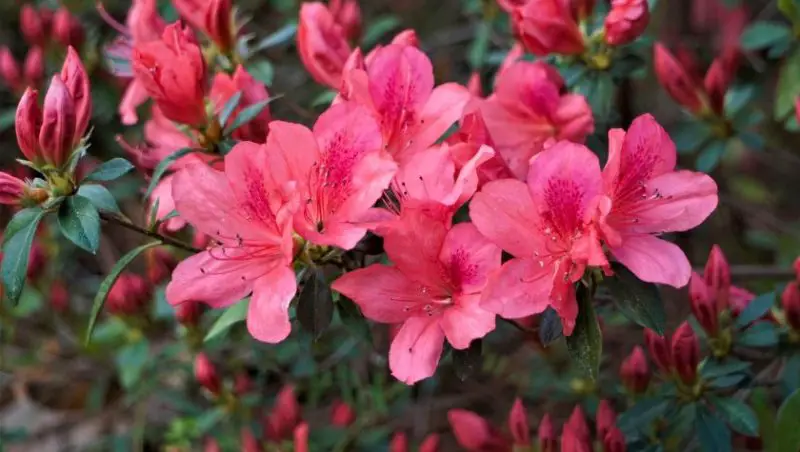Azalea trees, known for their stunning blooms and captivating colors, are a beloved choice among gardeners. Their ability to thrive in various climates makes them a versatile addition to many landscapes.
In this comprehensive guide, we’ll cover everything from the best planting practices to detailed care tips, helping you ensure your azaleas flourish year after year.
What is an Azalea Tree?

The azalea tree belongs to the Rhododendron genus, part of the Ericaceae family. Native to Asia, Europe, and North America, azaleas come in many varieties, either evergreen or deciduous. Their growth rate is slow to moderate, depending on the species, with mature heights ranging from 3 to 20 feet tall and spreads up to the same width.
Azaleas are known for their elliptical leaves and clusters of funnel-shaped blooms that appear in spring. The flowers, which can range from white, pink, purple, red, yellow, and even orange, bring a burst of color to any garden. These shrubs thrive in USDA hardiness zones 6-8 and are well-known for their love of acidic, well-drained soil.
Best Planting Practices for Azalea Trees
When to Plant Azaleas
The ideal time to plant azalea trees is in the spring or early fall. Planting during these cooler seasons helps the roots establish before they are exposed to harsh weather. It is important to note that while a one-gallon container plant may bloom in its first year, it can take up to 10 years for azaleas to reach their full size.
Choosing the Right Location
Azaleas require partial shade for optimal growth. They prefer a spot where they can receive at least four hours of sunlight daily, ideally in the morning, with some shade in the afternoon. For hotter climates, choose a shadier spot to protect the flowers from wilting in extreme heat.
Soil Requirements
Azaleas thrive in well-drained, acidic soil with a pH between 4.5 and 6.0. If your soil is neutral or alkaline, consider amending it with peat moss to improve drainage and acidity. Ensure the soil remains moist but not soggy to prevent root rot, a common issue with azaleas.
Planting Technique
When planting azaleas:
- Dig a hole twice the width of the root ball but only as deep as the container.
- Backfill the hole with a mix of native soil and organic matter, such as compost or peat moss.
- Water thoroughly after planting and apply a layer of mulch (preferably pine bark mulch) around the base of the plant to retain moisture and regulate soil temperature.
Azalea Tree Care Guide
Light Requirements
Azalea trees flourish in areas with partial sun. In colder regions, they can tolerate full sun, but in warmer climates, it’s important to provide them with afternoon shade to prevent flower wilt.
Watering Azaleas
Azaleas need consistent moisture, especially during their blooming season. However, avoid overwatering as this can lead to root rot. A good rule of thumb is to water deeply once or twice a week, allowing the top few inches of soil to dry out between waterings. In dry springs, supplement natural rainfall with additional watering to ensure a vibrant bloom.
Temperature and Humidity
Azaleas are relatively hardy, but their tolerance to temperature and humidity varies by cultivar. Some varieties can withstand colder temperatures, while others thrive in milder climates. Ensure adequate air circulation around the plants to prevent fungal issues like mildew, especially in humid environments.
Fertilizing Azaleas
Azaleas benefit from fertilizers that are high in nitrogen, phosphorous, and potassium (15-15-15). Fertilize in late winter or early spring, but avoid feeding too late in the season as this can encourage new growth that may not survive the winter.
For alkaline soils, consider using acidifying fertilizers to maintain soil acidity. Products like Espoma’s Azalea-Tone are excellent options specifically designed for azaleas.
Pruning and Deadheading
Azaleas don’t require extensive pruning, but light trimming can encourage a bushier and fuller plant. Prune right after the flowering season in late spring to avoid cutting off next year’s buds. Deadheading, or removing spent flowers, is not necessary but can keep the plant looking tidy.
Common Azalea Varieties
There are many varieties of azaleas, each with unique characteristics. Here are a few popular types:
‘Rosy Lights’
A compact, deciduous variety that reaches 4 to 6 feet in height. This cold-hardy shrub blooms in late spring with rosy red flowers tinged with coral and blush. Ideal for zones 3-7.
‘Windbeam’
This small variety, growing 3 to 4 feet, produces pale pink flowers and olive green leaves that turn bronze in autumn. It is more tolerant of sun and heat than other azaleas and thrives in zones 4-8.
‘Golden Oriole’
A fast-growing variety with clusters of golden-yellow flowers. It’s a showstopper in early spring, perfect for adding a burst of color to your garden.
Propagating Azaleas
Azaleas can be propagated by stem cuttings or layering. Both methods are slow but effective for growing new plants.
Propagating by Stem Cutting:
- Cut a 5-inch stem from new growth in late spring.
- Remove leaves from the bottom inch of the cutting, dip it in rooting hormone, and plant it in a porous rooting medium.
- Place the cutting in indirect sunlight and cover with a clear plastic bag to retain moisture. Roots should form within 4-8 weeks.
Propagating by Layering:
- In late spring, choose a low-growing branch and bend it to the ground, burying a portion in the soil.
- Use a rock or stake to hold the branch in place. In about a year, the buried portion will develop roots and can be transplanted as a new shrub.
Overwintering Azaleas
For regions where temperatures drop significantly, it’s important to protect your azaleas from harsh winter conditions:
- Apply a thick layer of mulch around the root zone in late fall.
- For particularly cold climates, consider covering your azaleas with burlap to protect them from windburn.
- Water deeply before the ground freezes to help prevent winter burn.
Common Pests and Diseases
Azaleas can be affected by several pests and diseases, including:
- Aphids, mites, lacebugs, and mealybugs: Neem oil can help control these pests.
- Fungal diseases such as powdery mildew, rust, and leaf spot: Fungicides may be necessary to treat these, though they’re often cosmetic issues.
- Root rot caused by poor drainage: Ensure well-draining soil to prevent this deadly disease.
How to Encourage Blooming
A healthy azalea typically blooms without issue, but if yours is struggling, consider these tips:
- Increase sunlight exposure: Azaleas need some direct sunlight for optimal blooming.
- Proper pruning: Avoid cutting off the new buds forming for next year’s flowers.
- Balanced fertilization: Use fertilizers designed for acid-loving plants like azaleas.
Conclusion
Caring for azalea trees requires attention to detail, but the reward is worth the effort. With their vibrant flowers and wide range of colors, azaleas can be the highlight of any garden. By planting in the right location, providing acidic soil, and keeping up with regular care, your azalea tree will thrive and bloom beautifully year after year.






